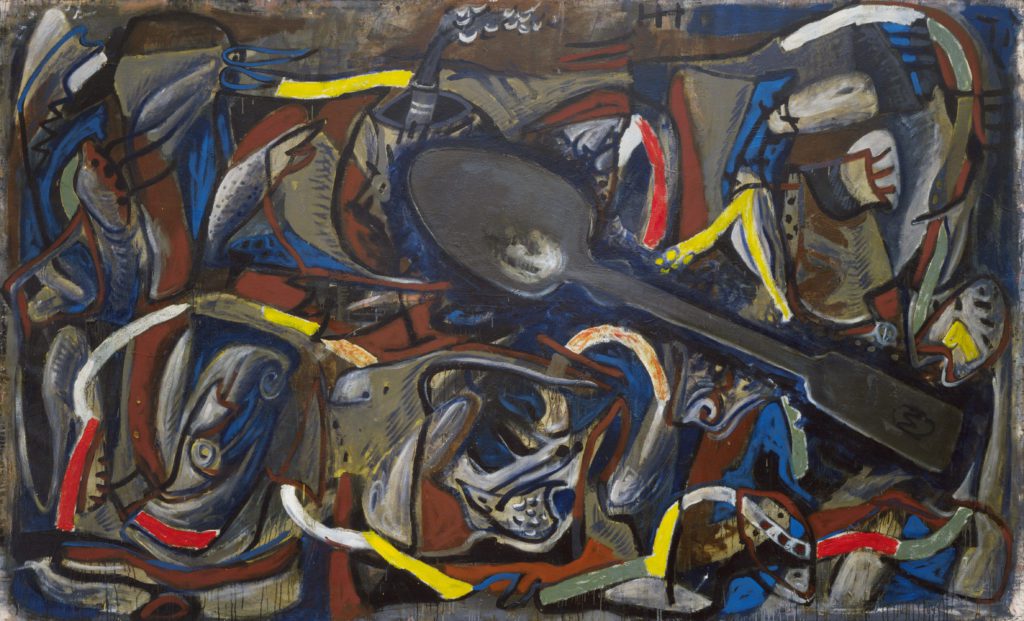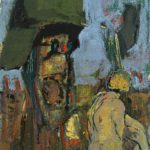Markus Lüpertz at the Phillips, Hirshhorn
By • July 12, 2017 0 890

The Hirshhorn just opened a major exhibition of rock-star Chinese artist Ai Weiwei, the museum’s third in five years. It is a highly personal landscape of political dissent, a sly, tempered, culturally informed response to current government oppression of political and humanitarian activists across the world. The show wags a scolding finger at government surveillance and honors the men and women who have sacrificed their personal freedoms in fighting for the rights of others.
Its intentions are honorable, but as art it falls short. The central work, a massive series of vectorized, technicolor Lego portraits of political activists that stretch neatly across the floor like orthopedic tiling, was originally conceived for Ai’s installation at Alcatraz, the legendary former island prison in San Francisco Bay.
I imagine that in an abandoned, moldy prison complex off the frigid coast of California, grainy headshots of some hundred-odd political prisoners tiling huge expanses of crumbling concrete floors had a significant impact. But on the second floor of the modishly annular Hirshhorn, it felt in turns misguided, sanctimonious and awkwardly fashionable, like those reusable Whole Foods bags printed with photographs of smiling African tribeswomen balancing wicker baskets on their heads.
Political art still needs to function foremost as art, as more than well-designed visual editorials. Because art is inherently a conversation with history and beauty, it does not work cleanly in conjunction with current events if divorced from the intellectual space it is afforded by its aesthetics.
I took the elevator downstairs to “Markus Lüpertz: Threads of History,” one of two Lüpertz exhibitions currently in Washington spotlighting the artist’s career, a collaboration between the Hirshhorn and the Phillips Collection. There I found what I was missing.
The German painter Markus Lüpertz also deals in his work with fraught sociopolitical environments — that of postwar Germany, and the ongoing story of a remarkable country coming to terms with itself in the wake of committing unspeakable humanitarian atrocities. The difference is that Lüpertz does this while also honoring art as a historical and political arena in itself.
- “Untitled,” 2008. Markus Lüpertz. Courtesy Phillips Collection.
- “The Large Spoon,” 1982. Markus Lüpertz. Courtesy Phillips Collection.
Lüpertz’s paintings feel like a beautiful progression of Western and German traditions, in the footsteps of the Weimar Republic, Der Blaue Reiter and German Expressionism, but looking further back at Classicism with a postwar lens like a fissure through classical and contemporary approaches.
Markus Lüpertz was born in 1941 in what was then Czechoslovakia, emigrating with his family to then-West Germany in 1948. Working as an artist throughout Germany, France and Italy since his mid-20s, he forged a career in a postwar Germany dominated by American abstraction and Pop Art, challenging and provoking the historical expectations of modernism in Europe. His success speaks for itself in the myriad biennales, formal critical recognitions and “Prix”-affixed accolades that have been bestowed upon him throughout the European Union.
The self-titled exhibition at the Phillips, “Markus Lüpertz,” explores the entirety of the artist’s five-decade career with a survey of his earliest works along with more recent paintings. The artist himself came to the museum to hang the show, which, unlike most retrospective exhibitions that are organized chronologically or thematically, places pieces from all eras of his career in conversation with one another. The result is one of the most visually fluid and satisfying exhibitions I have seen in years.
Over at the Hirshhorn, “Markus Lüpertz: Threads of History” is an in-depth exploration of his early work, including some large-scale canvases that reveal his early influences and a monumental ambition. Together, these exhibitions mark Lüpertz’s first major U.S. museum retrospective and a chance for American audiences to see the full creative evolution of a significant contemporary painter with a uniquely relevant historical voice.
It is rare that an exhibition has the power to change my perception of the work it contains while I am actively observing it, but here is perhaps an interesting example of this, and of why I found myself so taken by Lüpertz’s work.
There is a series of paintings throughout the Phillips exhibition plagued by the shadows of war: German military helmets, ravaged landscapes, obscured faces. Lüpertz handles paint violently and gorgeously, and the canvases are of course evocative. I perversely enjoyed the painterly display of 19th-century Modernism meeting its Nazi doom, and I could understand this being a fixation of a conscientious, postwar German artist concerned with history.
But I felt in the imagery of these paintings an oversimplification in the metaphor of war, as if warfare was simply an antithetical juxtaposition to art. It seemed obvious that following World War II these effects would loom over the psyche of reconstruction-era Germans with all the blunt, irreconcilable impact of the Berlin Wall. I thought the helmets were a straw man.
As I was noting this contention in my legal pad, however, it steadily occurred to me that this was actually a fine explanation for these crude, flatly-rendered German helmets, unchanging and visually inarticulate against complex and delicately violent environments of the surrounding paintings.
I am not German. I did not grow up in the 1950s. These helmets don’t diminish the complications of the Holocaust — it is probably just how it felt: an uncomfortably-shaped, dark, irremovable blotch with an ugliness that overshadowed any nuance, beauty, harmony, peace or balance that tried to exist in its presence. It was just that, a stain on a cultural landscape.
Amazingly, my favorite work in either show is among Lüpertz’s most recent paintings, from his Arcadian series of the 2010s. In “With the Help of the Grasshopper,” broken Roman marble sculptures litter a muted, gray marsh, all drips and brushstrokes with a strange softness that expresses both an ethereal delicacy and darkness. It is like the ancient artifacts of Western history were set loose in the wild and then frozen in place by the wrath of God amid a Bacchanalian revelry, to become overgrown and engulfed by nature like a civilization abandoned. There is also something to the tone, a greyness, that somehow seems integral to all this, like the shadows cast over history.
What is maybe most fascinating about Lüpertz’s work as a whole is that it elicits such visceral and emotional responses, yet it is sprinkled with intellectual breadcrumbs in all the right places, just enough that by the time your body finishes reacting, your brain has started spinning its wheels.



